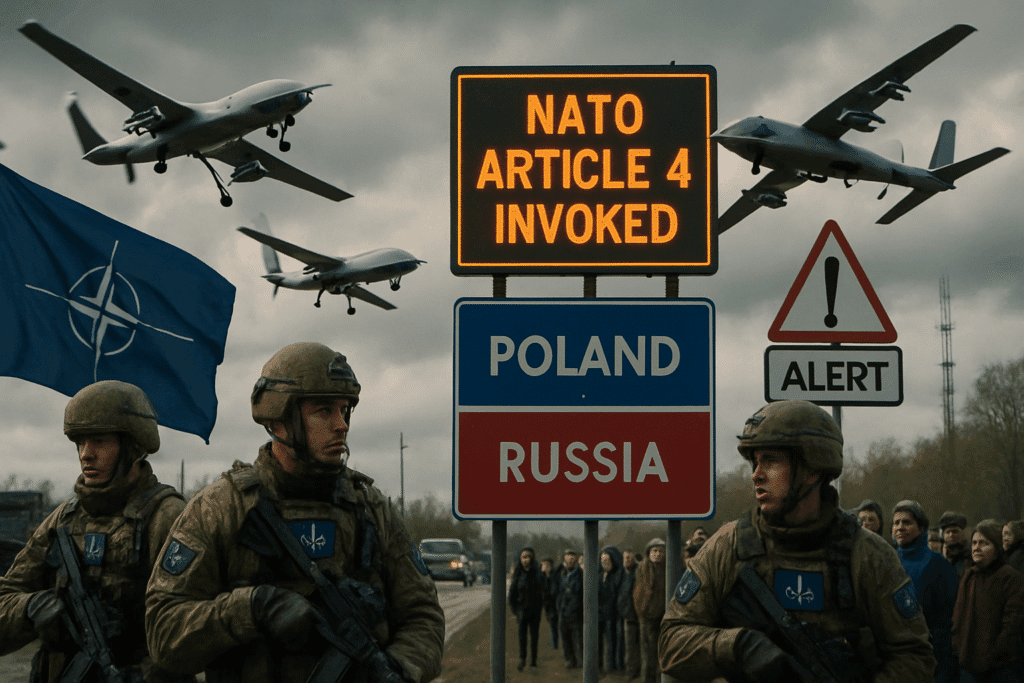NATO Article 4 has been invoked by Poland following unprecedented Russian drone incursions into Polish airspace on September 10, 2025. This historic moment marks the first time Article 4 has been triggered over unmanned aerial vehicles, escalating tensions between NATO and Russia to critical levels.
What is NATO Article 4 and Why Poland Invoked It?
NATO Article 4 allows any alliance member to request consultations when they perceive their territorial integrity, political independence, or security is threatened. Poland activated this provision after 19 Russian drones violated Polish airspace during a massive aerial assault on Ukraine.
Key Details of the Incident:
- 19 Russian objects entered Polish airspace
- Polish and Dutch fighter jets intercepted multiple drones
- NATO Secretary-General Mark Rutte confirmed the violations
- Emergency NATO consultations were immediately triggered
- Several drones were successfully shot down by allied forces

Understanding NATO Article 4 vs Article 5
While Article 5 declares an attack on one member as an attack on all, Article 4 serves as a consultation mechanism before potential collective defense action.
Article 4 Explained:
- Consultation and discussion forum
- Threat assessment and response planning
- Diplomatic engagement before military action
- Intelligence sharing among allies
- Coordination of defensive measures
Previous Article 4 Invocations:
- Turkey (2012): Syrian conflict spillover
- Turkey (2020): Syrian refugee crisis
- Poland (2022): Ukraine war concerns
- Poland (2025): Russian drone violations
Russia’s Drone Attack Strategy and NATO’s Response
The September 2025 incident involved sophisticated Russian drone warfare targeting Ukrainian infrastructure, with several unmanned vehicles crossing into NATO territory.
NATO’s Immediate Actions:
- Scrambled fighter jets from Poland and Netherlands
- Activated integrated air defense systems
- Enhanced border surveillance protocols
- Increased intelligence gathering operations
- Coordinated with Ukrainian defense forces
European Air Defense Implications
This incident highlights critical gaps in European air defense systems and the need for enhanced cross-border drone detection capabilities.
Defense Challenges:
- Small drone signatures difficult to detect
- Cross-border coordination complexities
- Rapid response time requirements
- Civilian airspace protection
- Electronic warfare countermeasures
Geopolitical Impact and Global Reactions
The drone incursion has triggered significant international responses and raised concerns about escalating conflict.
International Reactions:
- US: Full support for NATO Article 4 invocation
- UK: Increased military readiness announced
- Germany: Enhanced border security measures
- France: Diplomatic engagement with Russia
- Ukraine: Calls for joint European air defense
Economic Market Effects
Global markets reacted swiftly to the NATO Article 4 announcement:
- European defense stocks surged 8-12%
- Oil prices increased by 4% on supply concerns
- Currency volatility in Eastern European markets
- NATO defense spending commitments reassessed
Russia’s Official Response and Denial
Moscow initially claimed the drone incursions were “unintentional” and resulted from “technical malfunctions” during their Ukrainian operations.
Russia’s Claims:
- Denied deliberate airspace violations
- Blamed technical failures in targeting systems
- Rejected NATO’s escalation concerns
- Threatened response to “aggressive” interceptions
- Called for dialogue through diplomatic channels
NATO Article 4 Process and Next Steps
The Article 4 consultation process follows established protocols for threat assessment and response coordination.
Consultation Timeline:
- Immediate Phase (0-24 hours): Emergency consultations
- Assessment Phase (24-72 hours): Threat evaluation
- Response Phase (3-7 days): Action planning
- Implementation Phase: Coordinated measures
Potential NATO Responses
Military Options:
- Enhanced air defense deployment
- Increased Baltic air policing missions
- Forward positioning of defensive systems
- Joint training exercises acceleration
- Intelligence sharing expansion
Diplomatic Measures:
- Direct communication with Moscow
- UN Security Council engagement
- Bilateral discussions with allies
- Public information campaigns
- International law enforcement
Historical Context: NATO Article 4 Invocations
This marks the fifth time Article 4 has been invoked in NATO’s 75-year history.
Previous Invocations Timeline:
- 2001: Turkey after 9/11 attacks
- 2012: Turkey over Syrian border tensions
- 2020: Turkey during Syrian refugee crisis
- 2022: Eastern European members over Ukraine
- 2025: Poland over Russian drone violations
Impact on Ukraine-Russia Conflict
The NATO involvement could significantly alter the dynamics of the ongoing Ukraine conflict.
Strategic Implications:
- Increased Western military support for Ukraine
- Enhanced air defense systems deployment
- Strengthened NATO eastern flank
- Potential for conflict escalation
- Diplomatic pressure on Russia
Future Defense Cooperation
Enhanced NATO Measures:
- Joint air defense systems development
- Real-time intelligence sharing protocols
- Coordinated drone countermeasures
- Cross-border rapid response teams
- Advanced early warning systems
Expert Analysis and Security Assessment
Defense experts warn this incident could represent a new phase in NATO-Russia tensions.
Security Experts’ Views:
- “This crosses a red line in NATO territory violations” – Defense Institute
- “Article 4 invocation shows alliance solidarity” – Atlantic Council
- “Russia testing NATO response capabilities” – RAND Corporation
- “Drone warfare entering new territorial phase” – CSIS Analysis
Conclusion: NATO Article 4 and Future Security
The NATO Article 4 invocation by Poland represents a critical moment in European security architecture. As Russian drone technology becomes more sophisticated and conflicts spill across borders, NATO’s collective defense mechanisms face new challenges.
The alliance’s response to this unprecedented drone incursion will likely shape future defense policies and demonstrate NATO’s resolve in protecting member territories. With enhanced air defense systems and strengthened cooperation protocols, NATO aims to prevent future violations while maintaining diplomatic channels for de-escalation.
Key Takeaways:
- NATO Article 4 successfully triggered immediate consultations
- Polish-Dutch air defense cooperation proved effective
- Russian drone warfare tactics require new NATO responses
- European air defense systems need enhancement
- Diplomatic solutions remain the preferred path forward
As tensions continue, the international community watches closely to see how NATO’s Article 4 consultations will shape the future of European security and defense cooperation in an era of advanced unmanned warfare technology.

